
Fixed Deposits (FDs) are popular investment instruments that provide individuals with a secure and reliable way to grow their savings. FDs offer assured returns with low risk, making them a preferred choice for conservative investors. One aspect that potential investors need to consider when opting for an FD is whether they want to go for a cumulative or non-cumulative option. In this blog, we will delve into the nuances of these two types of FDs and help you understand their key differences.
What is Cumulative FD?
A cumulative fixed deposit is a type of investment where the interest earned on the principal amount is re-invested into the FD itself. Instead of being paid out periodically (like monthly, quarterly, or annually), the interest is compounded and paid along with the principal amount at the end of the FD tenure. In simple terms, the interest “accumulates” over time and is received as a lump sum at maturit
What is Non-cumulative FD?
On the other hand, a non-cumulative fixed deposit is the conventional type of FD where the interest earned is paid out at regular intervals as per the investor’s choice. The interest paid out could be monthly, quarterly, half-yearly, or annually, depending on the FD scheme. Unlike cumulative FDs, the interest does not accumulate here, and investors can receive a steady income stream at the chosen frequency.
Difference between Cumulative and Non-cumulative Fixed Deposit
Here’s a table highlighting the key differences between Cumulative and Non-cumulative Fixed Deposits:
| Aspect | Cumulative FD | Non-cumulative FD |
|---|---|---|
| Interest Payouts | Paid as a lump sum at maturity. | Paid regularly at chosen intervals. |
| Accumulation of Interest | Interest is re-invested, leading to higher overall returns. | Interest needs to be re-invested, resulting in lower returns than cumulative FDs. |
| Income Stream | Not suitable for regular income needs. | Ideal for individuals seeking a steady income stream. |
| Taxation | Interest is taxable annually, even though it’s re-invested. | Interest is added to income and taxed annually based on the investor’s tax slab. |
| Suitability | Suitable for long-term goals and those willing to wait for maturity. | Ideal for those requiring regular income or supplementing existing income. |
Cumulative vs Non-Cumulative FD – 4 Major Differences
- Interest Payouts: The primary difference between the two types of FDs is how the interest is paid-out. Cumulative FDs offer a lump-sum payout at the end of the tenure, while non-cumulative FDs provide regular payouts throughout the tenure.
- Accumulation of Interest: In a cumulative FD, the interest compounds over time, leading to a higher overall payout at maturity. On the other hand, in a non-cumulative FD, the interest is not reinvested, resulting in lower returns compared to cumulative FDs.
- Income Stream: Non-cumulative FDs are more suitable for individuals seeking a steady income stream, as they provide periodic payouts that can be used for regular expenses. On the other hand, cumulative FDs are ideal for those who want to grow their savings substantially and are willing to wait until maturity to receive the interest.
- Taxation: Taxation on interest earnings can differ for cumulative and non-cumulative FDs. In non-cumulative FDs, the interest earned is added to the investor’s income and taxed accordingly yearly. In cumulative FDs, the interest is also taxable annually, even though it is re-invested. Still, the investor receives the total interest amount at maturity, resulting in potentially higher tax implications.
How to Maximize Your Fixed Deposit Returns?
To maximise your fixed deposit investment, consider the following tips:
- Look for the best interest rates.
- Consider special FDs for senior citizens with higher interest rates.
- Choose the right tenure for your financial goals.
- Ladder your FDs for a more regular income stream.
- Opt for auto-renewal to benefit from compounding.
- Understand the tax implications and explore tax-saving options.
- Avoid premature withdrawals to avoid penalties.
- Diversify your investment portfolio to balance risk and returns.
- Stay informed about interest rate trends and economic developments.
Cumulative FD vs Non-Cumulative FD – Which One to Choose?
Choosing between a cumulative and non-cumulative FD depends on your financial goals and requirements. If you want to grow your savings significantly and can do without regular interest payouts, a cumulative FD might be the right choice. On the other hand, if you need a steady income stream or want to supplement your existing income, a non-cumulative FD would be more suitable.
Additionally, consider the impact of taxation on your earnings and consult with a financial advisor to make an informed decision based on your specific financial situation.
Conclusion
Both cumulative and non-cumulative fixed deposits have their unique advantages, and the choice boils down to your financial objectives and risk tolerance. Cumulative FDs provide higher overall returns, while non-cumulative FDs offer regular income. Before making a decision, thoroughly assess your financial needs and future plans to make the most out of your fixed deposit investment.
FAQs
While some banks may allow you to switch between the two types, it is not advisable. Choosing the type that aligns with your goals from the beginning is better.
Yes, the interest earned on fixed deposits is taxable as per the investor’s income tax slab.
Senior citizens often prefer non-cumulative FDs as they provide a regular income stream which can supplement their retirement expenses.
Premature withdrawal from a cumulative FD may result in a lower interest payout or penalty, depending on the bank’s policies.
Disclaimer
This article is solely for educational purposes. Stable Money doesn't take any responsibility for the information or claims made in the blog.


